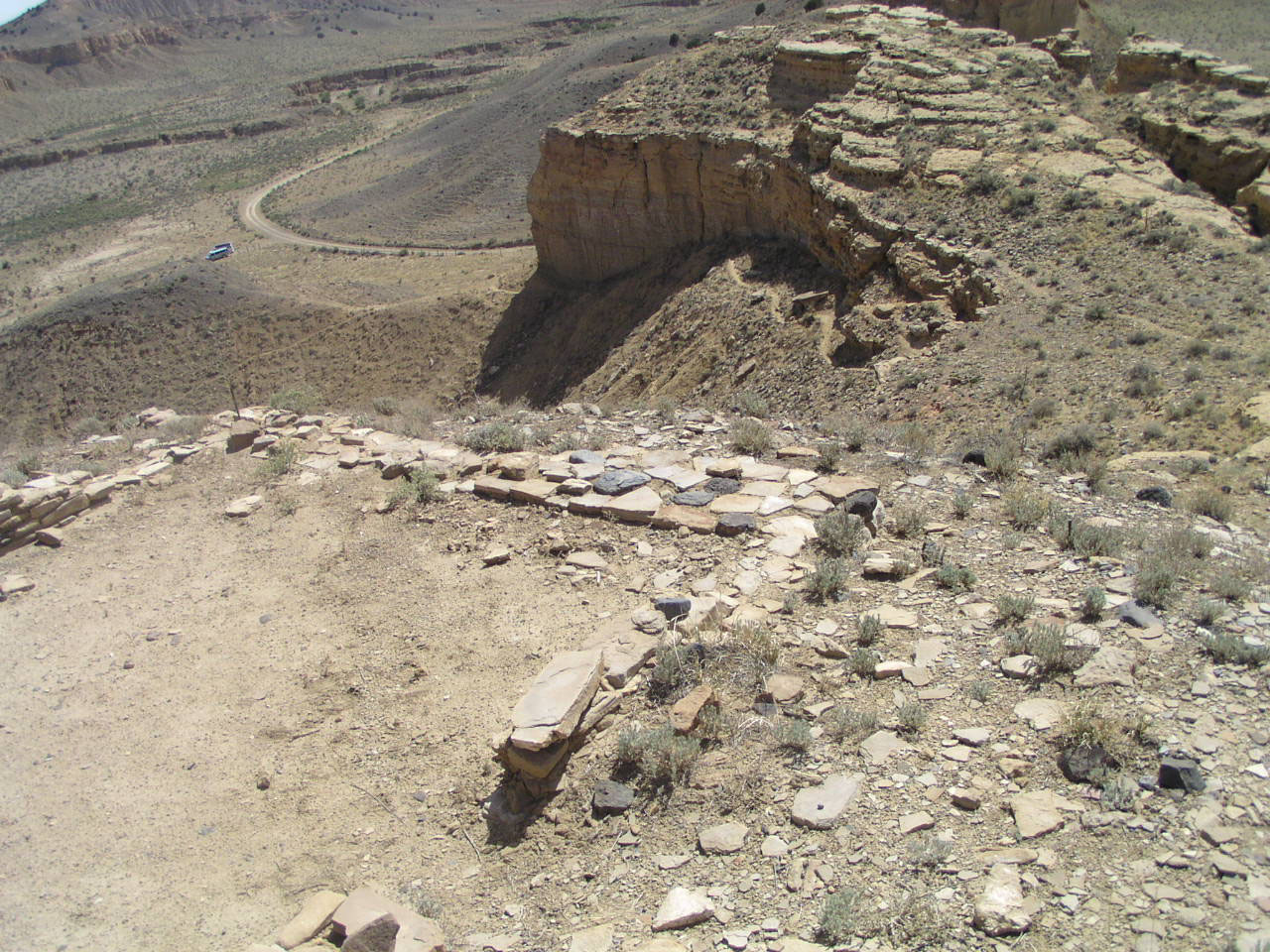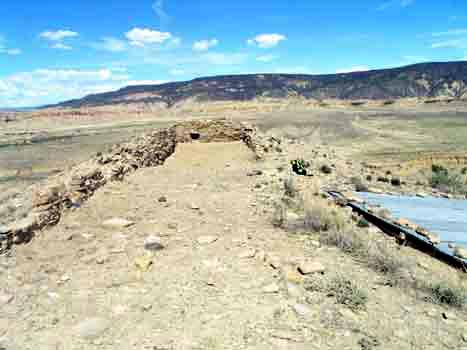A. Brockway's Ancient Southwest— Report #7 (Part I)
Far Away Outliers 1
The discussion of Chocoan outliers began in Report #5 on the Chaco Phenomenon, so it might not be a bad idea to take a glance at it again, particularly at the map. As the name indicates, outliers are communities with Chaco-like buildings that lie some distance from Chaco Canyon itself; they "lie outside" the Chaco Core. In this Report we'll look at three of the most distant such outliers: Guadalupe, the farthest east outlier (about 60 miles southeast of Chaco); Chimney Rock, 85 miles to the northeast; and Lowry Ruin, 120 miles northwest.
Guadalupe is a small outlier. The earliest dates for its great house, which stood one story high and consisted of something like twenty-eight rooms including three kivas, is in the late 10th century. Despite the Chacoans' superb building skills, it would be hard to imagine a much larger structure on the narrow ridge high above the East Puerco River. Like many prehistoric sites in the American Southwest, Guadalupe was occupied by various peoples at various times. There were at least four distinguishable occupation periods of which the Chacoan (960-1130) is most visible in the ruins remaining today.
In addition to the great house itself, the "Guadalupe community" consisted of twenty-four small houses—including a somewhat larger small house known as the Eleanor Ruin—that cluster, with one exception, on the south side of Guadalupe Mesa. No great kivas have been found, though an unexcavated depression, not large enough to be your standard great kiva, has attached rooms as great kivas do and conceivably could have functioned, in its constrained but highly visible setting, as some sort of community building. (Durand & Durand 2000: 106).
|  |
 |
Guadalupe is an unusual outlier in a number of ways. It is out there on the edge all by itself: there are no great houses further east (Lekson 1999:38). But it is thoroughly Chacoan, complete with core-and-veneer masonry and T-shaped doors. Even the smaller Eleanor ruin, on the plain at the base of the mesa, sports core-and-veneer and a T-door (Durand & Durand 2000: 106). Especially, its early date sets it apart. A 960 tree-ring date (but see Vivian 1990: 211) indicates that construction at Guadalupe began before all but three of the Chaco Canyon great houses themselves, when the "Chaco Phenomenon" hadn't even been a dream. What was it doing out there?
Apart from the fact that there was good farm land round about, Guadalupe's geographical setting placed it on the natural route into the San Juan basin from the east. Unfortunately, no roads have been found that lead to or from the outlier, though the Chacra Face road, which ran eastward from the Una Vida great house in the Canyon, might very well have continued on to Guadalupe (Vivian and Hilbert 2002: 73). |
On the assumption (which rests on less than rock hard data) that the 10th century date for Guadalupe is reasonably correct and on the clear architectural evidence that Guadalupe was built in Chaco style, it is only reasonable to ask an obvious question: What was Guadalupe's role in the drama that was to develop, a century later, into the Chaco Phenomenon? A possible answer consists of one word: turquoise.
Turquoise was important for the people of Chaco, especially for the inhabitants of the large great houses, Pueblo Bonito in particular. For example, the burials of two apparently high status individuals in Room 33 of Pueblo Bonito, which date to the period when Guadalupe began (900-1040—"Early Bonito"), contained large amounts of finished turquoise objects. A number of other rooms also yielded turquoise. Some of the niches in the wall of the great kiva at Chetro Ketl contained turquoise pendants (Report # 2). Turquoise objects were buried in the floor of Casa Rinconada. And on and on.
Not all the turquoise found in Chaco graves and buildings was worked. In fact, scraps of the highly prized mineral were found in floors and pilasters of kivas great and small. It would appear that turquoise was important because it was turquoise, even if it wasn't made into finished objects. In addition to its considerable intrinsic value as a trade item (was it even a medium of exchange?), turquoise had also had a ritual role to play even as far back as the Basketmaker periods that preceded Chaco culture itself (Mathien 2001: 115).
The turquoise found at Pueblo Bonito and other great houses (and to a far lesser extent in small houses) in Chaco Canyon came from several sources but the principal mines were near the present New Mexican town of Cerrillos, south of Santa Fe. And that brings us back to Guadalupe. Guadalupe, situated on a high ridge that provided visibility for miles around, was roughly half way between Cerrillos and Pueblo Bonito. It was a way stop or, better perhaps, a check point on the "Turquoise Road."
By the first part of the eleventh century, Chaco appears to have been firmly in control of turquoise processing, which had started in the canyon as much as a century before (Frazier 1999: 183). Any way you look at it, the unprecedented use of turquoise in Chaco Canyon during the height of the Chaco Phenomenon is impressive. Chaco had more turquoise than everybody else in the Southwest put together (Weigand 1992: 169). The folks there needed to have control of the source, something Guadalupe was perfectly situated to do.
Some scholars are reluctant to assert that Chacoans controlled their source(s) of turquoise (Mathien 2001: 105). Whether or not the source itself was strictly controlled by them, it would certainly seem that they strictly supervised the transport of the valuable mineral. While no finished turquoise products (e.g. jewelry) were found at Guadalupe, scraps of the mineral are amply evident (Frazier 1999: 183), which may suggest that turquoise was worked there even if the finished pieces were destined elsewhere. Even the ants testify to the Turquoise Road: little bits of turquoise were found in their middens ((Durand & Durand 2000: 107). Turquoise certainly passed through Guadalupe (on its way to Pueblo Bonito?). Were "Chaco Rangers" there to ensure its safe passage? It's tempting to think so.
Directly north from Guadalupe, in Colorado, is another far away outlier, called Chimney Rock
|
 |

